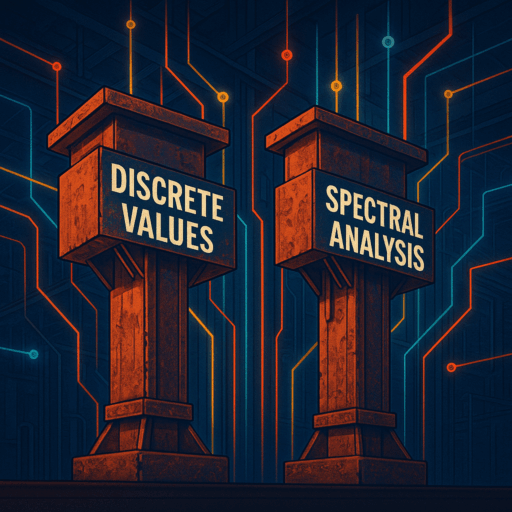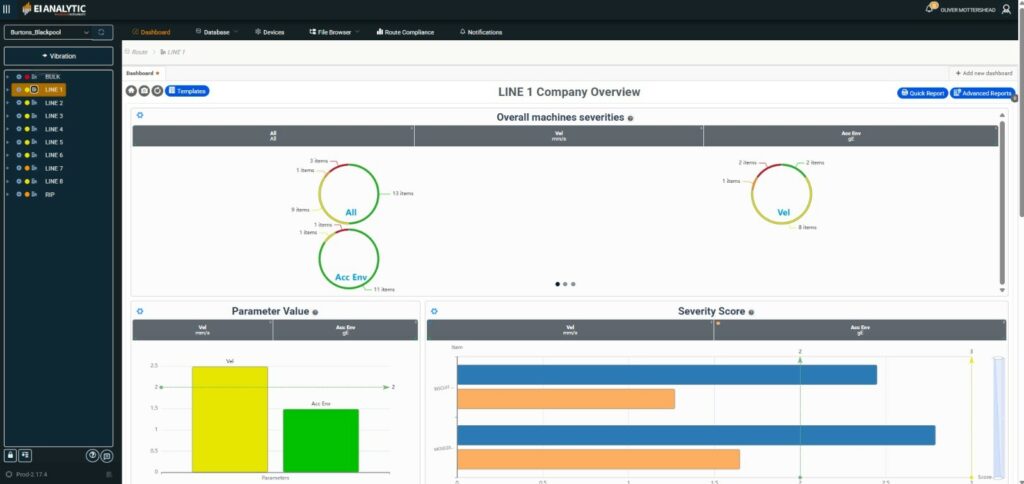Predictive maintenance has moved from buzzword to boardroom strategy. Across industries, companies are waking up to the obvious: waiting for equipment to fail is too expensive.
Vibration analysis, once niche, is now mainstream. Instead of reacting to failures, companies are using vibration data to anticipate them. Online vibration monitoring systems are quickly replacing scheduled, route-based measurements. These systems are cheaper in the long run, more scalable, and infinitely more informative. They generate torrents of data.
What Vibration Data Actually Tells You
When you strip away the hype, vibration analysis rests on two pillars:
Discrete Values: Things like velocity RMS, crest factor, or high-frequency acceleration. These single-number metrics, plotted over time, reveal when something is trending in the wrong direction. Even simple threshold alarms can alert you of things going wrong.
Spectral Analysis: The harder problem. By analyzing the frequency spectrum of a vibration waveform, you can diagnose unbalance, misalignment, bearing faults, cavitation, and a laundry list of failure modes. But this requires trained personnel, experience, and sophisticated tooling.

Why Companies Want to Build Their Own
Large organizations are allergic to lock-in. They want control, independence, and not to depend on a single provider.
- Data ownership: With in-house software, you decide where your sensor data lives and how it’s used. No vendor black box.
- Strategic alignment and customization: Custom platforms can integrate with your Industry 4.0 initiatives, IoT dashboards, or A-I driven analytics. Combining vibration data with all the rest of your process data can be quite useful and give more insights.

The Hard Parts Everyone Underestimates
Building predictive maintenance software is not like writing a web app. It’s closer to designing a flight control system: specialized, unforgiving, and deceptively complex.
- The math is hard: FFTs, order tracking, envelope analysis–this isn’t a weekend project. Without years of vibration expertise, your “dashboard” will miss subtle failure patterns.
- You give up decades of expertise: Manufacturer software isn’t just visualization–it encodes diagnostic knowledge refined across industries.
- Time-to-value stretches: Vendor platforms are usable in weeks. Internal projects can take months before delivering real insights.
This isn’t to say you shouldn’t build. But you should know exactly what you’re signing up for.
A Smarter Middle Ground: Hybrid Adoption
The most pragmatic companies take a hybrid approach.
They start with vendor software–battle-tested, quick to deploy and immediately useful. This provides early wins: instant alarms, diagnostic libraries, and machine learning features out of the box. Meanwhile, they experiment with their own tools in parallel, slowly layering dashboards, ERP/SCADA integrations, and custom analytics on top.
The hybrid path delivers the best of both worlds: vendor expertise plus organizational independence. It avoids the paralysis of a long internal development while still supporting long-term control over data and strategy.
Real-World Lessons
I’ve seen both successes and failures.
- A global food producer started with off-the-shelf vibration analytics. Within months, they prevented two critical bearing failures. A year later, their internal team began layering predictive models tailored to their conveyor systems. Today, they have a dual-stack system: vendor software for diagnostics, in-house software for operations data augmented with vibration data.
- A beauty manufacturing conglomerate tried to go “all in” on custom software from day one, outsourcing development to an outside firm. After many months, the project was quietly shelved.
The Bottom Line
Building your own predictive maintenance software for vibration sensors can be bold, liberating, and–done right–transformative. But it’s not a shortcut. It demands resources, expertise, and patience.
For most organizations, the wisest strategy isn’t binary. It’s hybrid: lean on vendor platforms for proven diagnostics, while building your own layers where you truly need differentiation.
Pablo Mendoza, Director of Development at ERBESSD INSTRUMENTS®, has 25 years of experience in programming, automation, networking, and digital electronics industries. He has worked in leading IT companies and industrial environments, specializing in automation at all levels. Passionate about technology, he has contributed to open-source projects and hosted a radio show dedicated to technology. Pablo has extensive technical knowledge in programming, networking, databases, operating systems, electronics, microcontrollers, and embedded systems. 7 years ago, he joined ERBESSD INSTRUMENTS where he contributed to the development of the company’s hardware products, including WiSER3X, GX400, and the PHANTOM® system.
ERBESSD INSTRUMENTS® is a leading manufacturer of Vibration Analysis Equipment, Dynamic Balancing Machines, and Condition Monitoring with facilities in Mexico, the USA, England, India, and Colombia.
